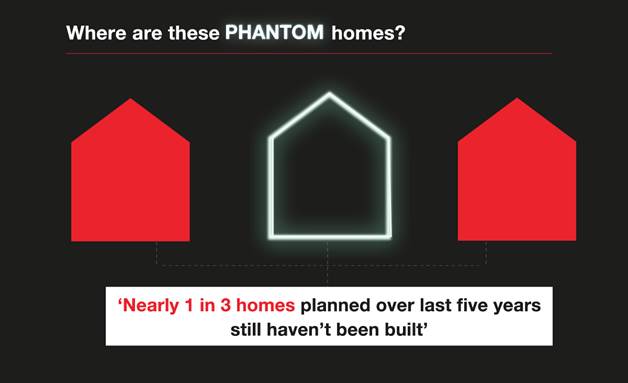Phantom Homes: Nearly one in three houses don't get built despite being given go-ahead
Posted 06 Jul 2017
Housebuilders have failed to build more than 320,000 homes in the past five years even after being given the go-ahead, according to new research out today.
Figures from housing charity Shelter reveal this equates to nearly one in every three homes in England granted residential planning permission in the past five years. The problem is particularly acute in London where one in two remain unbuilt 'Phantom Homes'.
In the same time period, the profits of the country’s top five housebuilders have soared by an astronomical 388% to a total of £3.3bn in 2016, according to the research.
Developer profit margins also increased over this time, along with payouts to their shareholders which rose to nearly £1 billion a year.
Anne Baxendale, head of communications, policy and campaigns at Shelter, said: "Housebuilders are trickling out a handful of poor quality homes at a snail’s pace meaning there are simply not enough affordable homes and ordinary working families are bearing the brunt.
Shelter is warning that the country’s current housebuilding system encourages developers to sit on land and drip out new homes so as to keep prices high. The housing charity is calling on the government to get tough on developers by giving councils the power to tax those who aren’t building fast enough, as well as taking forwards policies outlined in the housing White Paper like granting planning permission to developers based on their track record.
"While people across the country struggle with eye-wateringly high housing costs, developers' profits are soaring into the billions. Time and again we hear the ‘red tape’ of the planning system being blamed but the real problem is a system where developers make more profit sitting on land than they would by building homes.
"It's clear our housebuilding system has failed the nation but the government can turn things around by supporting a whole new approach. Shelter's New Civic Housebuilding model listens to the needs of communities and gives more powers to councils to get developers building the high-quality genuinely affordable homes we need."
Elizabeth, 35, rents in Worthing with her husband and their two children. She feels they have been completely priced out of owning a home of their own.
“My husband and I have been renting since we met 13 years ago. Despite him working his way up to a management position and myself working long hours, we've never been in a position to save anywhere near enough for a deposit on a house.
“We’ve more or less given up on the idea now. With two teenage children we need a place that can fit a whole family but that just seems impossible. Maybe when our children have grown up and left home we can finally get a small place for the two of us but it breaks my heart that we will never have a real family home of our own.”
ENDS
Notes to editors:
Case studies of sites with planning permission that have gone unbuilt as well as renters struggling to get on the housing ladder are available upon request. Please call the Shelter press office on 020 7505 2162
New Civic Housebuilding is an approach endorsed by a range of organisations including the Prince’s Foundation for Building Community.
Research
The worst performing regions (all below the England average):
| Area | Estimate Completions as percentage of planning permissions last 5 years (permissions lagged one year) | 5 year 'shortfall' |
|---|---|---|
| London | 52% | -106968 |
| North West | 62% | -46112 |
| Yorkshire and the Humber | 66% | -27659 |
| England | 68% | -324315 |
Figures account for a one year lag between permission being granted and a unit being built. If no lag had been utilised, completions would only have been 63% of planning permissioned units between 2011/12-2015/16. The shortfall would have been 413,000 homes.
Estimated UK profits before tax and exceptional items for the top five developers: increased by 388% from £674m (2011) to £3.3bn (2016). Dividends paid to shareholder totalled £936m in 2015.
The top 5 developers by 2015/16 UK housebuilding revenue were (in order): Barratt Developments PLC, Taylor Wimpey PLC, Persimmon PLC, Berkeley Group Holdings PLC, and Bellway PLC.
Calculations on planning permissions (2010/11-2014/15) based on figures from Home Builders Federation / Glenigan quarterly ‘Housing Pipeline’ reports. Completions analysis (2011/12-2015/16) based on DCLG figures (Table 120). Permission to completion lag estimates based on data from Nathaniel Lichfield and Partners ‘Start to Finish’ (2016).
Profits figures calculated with the kind assistance of Dr Tom Archer, using developers’ accounts and following methodology of CRESR ‘Profits before Volume’ (2016). CRESR’s segmental approach was informed in consultation with a qualified accountant, and isolated revenue generated from UK housebuilding activity from developers’ other activity.
CRESR’s segmental approach was informed in consultation with a qualified accountant, and isolated revenue generated from UK housebuilding activity from developers’ other activity.

